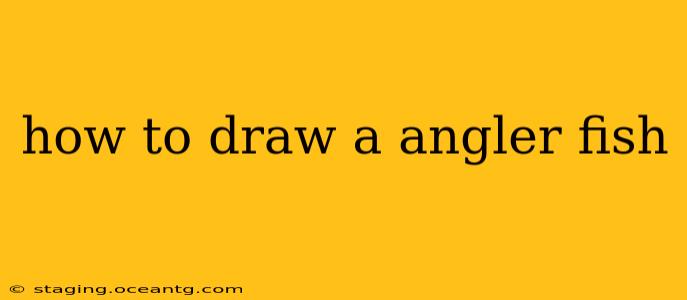The anglerfish, with its bioluminescent lure and terrifyingly deep-sea appearance, is a fascinating subject for any artist. This guide will walk you through drawing an anglerfish, step-by-step, whether you're a beginner or more experienced. We'll cover various aspects, from its unique body shape to its iconic lure.
Getting Started: Materials and Basic Shapes
Before we begin, gather your materials:
- Paper: Use any drawing paper you prefer; sketchbook paper or printer paper will work fine.
- Pencils: A range of pencils (e.g., HB, 2B, 4B) will allow you to vary line weight and shading. An eraser is essential!
- Optional: Colored pencils, markers, or paints to add color and detail.
We'll start with basic shapes to create the anglerfish's form. Think of it as building blocks:
-
The Body: Draw a large, slightly irregular oval for the main body. It shouldn't be perfectly symmetrical; anglerfish are a bit… lumpy.
-
The Head: Add a smaller, rounded shape on top of the oval, slightly overlapping. This forms the head.
-
The Mouth: Draw a large, slightly curved line beneath the head, extending downwards. Add a few jagged, triangular teeth inside the mouth. Anglerfish mouths are impressive!
-
The Dorsal Fin (Lure): Above the head, draw a thin, slightly curved line extending upwards. This is the base of the dorsal fin. At the very tip, draw a small, rounded circle to represent the bioluminescent lure.
Refining the Anglerfish Drawing
Now let's add detail and refine our basic shapes:
-
The Body Details: Add a slightly bumpy texture to the body using small, curved lines. Anglerfish aren't smooth; they're often covered in small protrusions and skin flaps.
-
The Fins: Draw smaller, triangular fins on the sides of the body. These fins are usually quite small compared to the body size. Remember they're not perfectly symmetrical either.
-
The Eyes: Add small, round eyes on either side of the head. Anglerfish eyes are usually quite small and relatively far apart.
-
The Lure Details: Add a few small, radiating lines from the lure to simulate its bioluminescence. You can also add some shading to make it stand out more.
Adding Depth and Shading
To make your anglerfish drawing more realistic, consider adding shading and depth:
-
Light Source: Decide on a light source. This will help determine where the shadows should fall on the fish.
-
Shading: Use darker pencil tones to shade the areas that are further away from the light source, creating depth and dimension. Pay particular attention to the curves and folds of the body to create a three-dimensional effect.
-
Highlights: Leave small areas un-shaded to create highlights that add to the realism of your drawing.
Adding Color (Optional)
If you're using colored pencils, markers, or paints, consider these color suggestions:
- Body: Dark browns, blacks, or deep grays work well.
- Lure: A bright, glowing yellow or orange creates a stark contrast.
- Eyes: Small, reflective dots of white or light yellow.
- Fins: Similar to the body color, but possibly with a slightly lighter shade.
Frequently Asked Questions (FAQ)
How do I draw the anglerfish's lure realistically?
The lure should be small and bulbous, often with a slight stem connecting it to the dorsal fin. Adding radiating lines or shading to the lure will help create the illusion of light emanating from it.
What type of pencil should I use?
A range of pencils, from HB to 4B, are recommended to provide a variety of shading options. Start with a lighter pencil (HB) for outlining and sketching, then move to darker pencils (2B, 4B) for shading and adding detail.
How do I draw the anglerfish's teeth?
Anglerfish have numerous, sharp teeth pointing inwards. Start by outlining the general shape of the mouth, and then add many small, triangular teeth within the mouth, pointing inwards.
How do I make my anglerfish drawing look 3D?
Careful shading and highlighting, using light and shadow to define the curves and form of the fish, is essential to achieving a 3D effect. Observe reference images of anglerfish to understand how light and shadow interact with their bodies.
With practice and patience, you'll be able to create a truly captivating drawing of this fascinating deep-sea creature. Remember to observe various reference images of anglerfish to get a good understanding of their unique features and body structure. Happy drawing!
